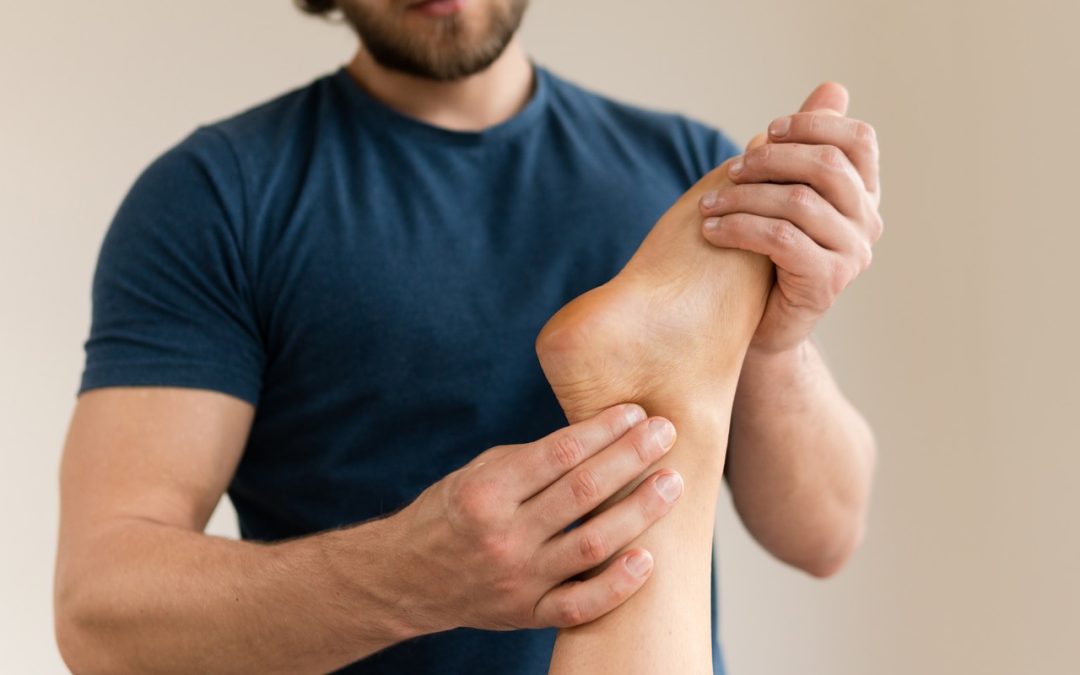Plantar Fasciitis is a common foot condition that causes the tissue on the sole of the foot to be inflamed, resulting in pain when pressure is put on the heel. It impacts individuals across various age groups, often leading to discomfort and pain if left unaddressed – but with the right management, the condition can often resolve with treatment.
At Healing Hands Osteopathy, we understand the challenges of Plantar Fasciitis and are committed to offering practical strategies for management and recovery. This comprehensive guide provides insights from experienced osteopaths in Croydon into understanding, treating, and managing the condition.
What is Plantar Fasciitis?
The plantar fascia is a crucial strip of thickened tissue stretching along the bottom of your foot, essential for supporting the foot’s arch and absorbing the impact of your steps. It is elastic enough to distribute your body weight evenly across your foot and is vital for efficient walking and running.
However, this resilience can be a double-edged sword. Extended foot activity can overstress and inflame the plantar fascia, which can lead to inflammation and pain. This is known as Plantar Fasciitis.
Causes and Symptoms
Plantar Fasciitis is typically caused by overstraining the foot through activities like excessive running or hiking, standing for long hours, or wearing unsuitable shoes, as well as by abnormal walking patterns that place extra pressure on the plantar fascia.
The hallmark symptom of this condition is a sharp, stabbing pain near the heel, which is most pronounced when taking the first steps after a period of rest, such as waking up or standing up after sitting for a while. Additionally, this pain often worsens after prolonged periods of standing or walking.
Treatment Approaches
Recognising the triggers and symptoms of Plantar Fasciitis early allows you to take remedial action quickly and prevent the condition from escalating. The primary strategy is to reduce the inflammation and allow the tissue to heal.
Osteopathic Treatment
Osteopathy, which uses various non-invasive techniques in soft tissue massages, joint manipulation and more to treat musculoskeletal injuries, can help you manage Plantar Fasciitis. This form of treatment reduces inflammation by improving blood flow and lymphatic drainage, relieving muscular tension and improving joint motion in the lower leg.
Exercises and Stretches
Besides osteopathic treatment sessions, we also recommend a few exercises and stretches that you can incorporate into your daily routine to treat Plantar Fasciitis, such as:
Calf Stretch Against Wall
- Stand facing a wall and press your hands against it for support.
- Take a step back with the leg you’re stretching, keeping it straight. Press the heel firmly towards the floor.
- Lean into the wall until you feel a stretch in your calf.
- Hold this position for 20-30 seconds. Repeat the stretch 3-4 times a day for optimal results.
Achilles Stretch
- Position yourself on a step, allowing the heel of the foot you’re stretching to extend off the edge.
- Carefully lower the heel below the step until you feel a stretch through your Achilles tendon and calf muscle.
- Maintain this stretch for 20-30 seconds. Perform it 3-4 times daily to enhance flexibility and relief.
Frozen Water Bottle Roll
- While seated, place a frozen water bottle on the ground and rest your foot on it.
- Gently roll the bottle back and forth beneath your foot for several minutes.
- This method stretches the plantar fascia and uses the cold to reduce inflammation. Perform this stretch 1-2 times a day.
Home Management Strategies
There are also several steps and lifestyle changes that you can do at home to help manage Plantar Fasciitis:
Ice Application
Applying ice to the sore area for 15 to 20 minutes several times daily can significantly reduce inflammation and pain, especially after activities.
Usage of Anti-inflammatory Medications
Over-the-counter anti-inflammatories like ibuprofen can provide quick relief from pain and swelling. However, they should be taken as directed and preferably after medical consultation.
Activity Modification
Limiting activities that worsen the pain, such as running or jumping, and opting for low-impact exercises like swimming can prevent further strain.
Footwear Adjustment
Wearing shoes with proper arch support and cushioning helps distribute foot pressure evenly, reducing stress on the plantar fascia. Avoid flat or unsupportive shoes such as high heels.
Combined, these strategies can accelerate healing, offer relief and prevent future discomfort. However, if symptoms persist, it is best to consult a medical professional as advanced treatments like physical therapy, orthotic devices or medical interventions may be necessary.
Treat Your Planar Fasciitis with Healing Hands Osteopathy
At Healing Hands Osteopathy, we offer a holistic and comprehensive approach to managing Plantar Fasciitis with our osteopathy services in Croydon. We aim not only to alleviate your immediate discomfort but also to address the root causes of your condition.
Our skilled osteopaths identify specific factors contributing to your pain through personalised assessments, employing manual therapy techniques such as soft tissue massage, stretching, and joint mobilisation to improve blood flow, reduce muscle tension, and correct biomechanical imbalances for you.
We also know healing doesn’t stop when you leave our clinic. That’s why we guide you through changes in your lifestyle and exercises that strengthen your recovery and foot health. Whether it’s choosing the right shoes or doing foot-friendly exercises, we’ve got you covered.
Don’t let Plantar Fasciitis fill your days with foot pain. Reach out to us and take the first step towards a pain-free, active lifestyle.

